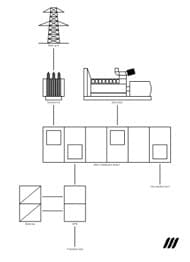Housing an organization’s IT operations, computer systems, and associated components, data centers are often described as the engine of the Internet. For this engine to operate smoothly, efficiently, and without any downtime, a reliable supply of power is needed. In this article, we provide a concise overview of the modern data center power infrastructure and describe its main components.
The power supply of every larger data center starts with a connection to the main grid, which is provided by the local utility company. We at Datacenter.com in Amsterdam use 2N power design, which means that our data center is connected to the national grid sectors with two separate transformers to protect our customers against the risk of downtime should one sector fail.
To ensure uninterrupted operation even in the case of a large-scale power outage, data centers are typically connected to at least one diesel or gas backup generator. The electricity from both the local utility company and the backup generator is delivered with a medium voltage (10 kV or 20 kV for our Netherlands data center, for example).
The medium-voltage electricity is then transformed by one or more transformers to low voltage (400 V in the Netherlands and many other countries) for use within the data center.
Main Distribution Boards (MDBs), which are panels or enclosures that house fuses, circuit breakers, and ground leakage protection units, take the low-voltage electricity and distribute it to a number of endpoints, such as Uninterrupted Power Supply (UPS) systems or load banks. MDBs additionally manage the incoming power from the main grid and can start the backup generator when they detect a power outage. Most data centers store enough fuel to keep the generator running for 24–48 hours.
Instead of distributing low-voltage electricity directly to sensitive computer electronic components and systems, MDBs pass it through an Uninterrupted Power Supply (UPS) system, which provides short-term power when the input power source fails and protects critical components against voltage spikes, harmonic distortion, and other common power problems.
Most UPS systems are designed to provide power for at least 5 minutes on maximum load during an outage. During those 5 minutes, the backup generation has enough time to make multiple attempts to start and take over the load from the UPS system.
This outline of a common data center power infrastructure roughly explains how modern data centers are able to supply enough power to meet the growing demand for connected information technology solutions.
Of course, only the best data centers make sure that all of the major components of the data center power infrastructure are in the best running condition possible to guarantee the highest uptime achievable. We at Datacenter.com go the extra mile to become the partner our customers deserve. By investing in state-of-the-art equipment and embracing the latest energy-efficient practices, we rise above our competition and set a pace for others to follow. You can learn more about our services by visiting our website.
